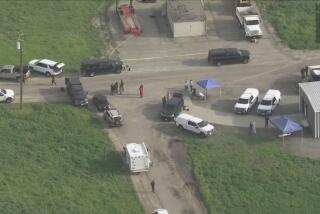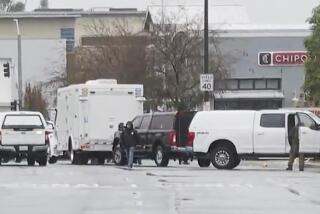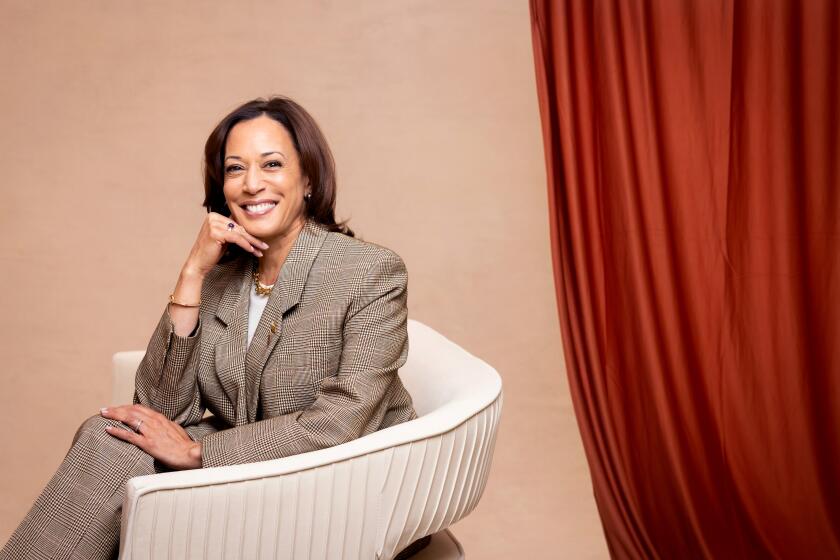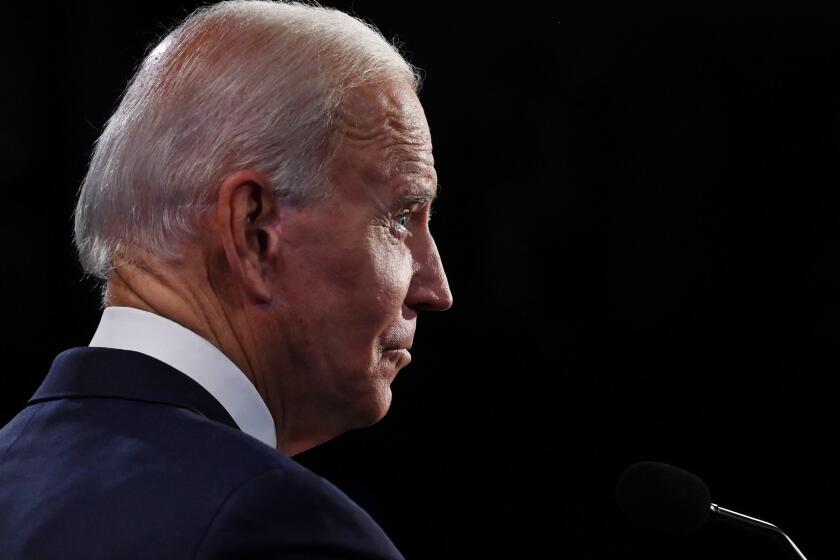Investigators Believe Bombing Was the Work of 4 or 5 People : Terrorism: Father, son are under scrutiny. FBI says 3 witnesses can place McVeigh near blast scene. Arizona town emerges as possible base for plotters.
Federal authorities now believe that four or five people were involved in the blast that destroyed the Alfred P. Murrah Federal Building in Oklahoma City and they are investigating a father-son team in the Midwest about explosives that may have been supplied to the bombers, a source familiar with the inquiry said Thursday.
As the nationwide search continued for those responsible for the worst act of domestic terrorism in U.S. history, sources close to the investigation said that the father operates a military-supply store in the small town of Antigo in north-central Wisconsin and that the son is believed to live in Chicago.
Meanwhile, at a hearing at the El Reno, Okla., Federal Correctional Center, the FBI said that three eyewitnesses were prepared to testify that they saw suspected bomber Timothy J. McVeigh, who is now in custody, driving toward or away from the Murrah building near the time of the explosion.
U.S. Magistrate Ronald Howland, saying that an “indelible trail of evidence” links McVeigh to the crime, ruled that the 27-year-old defendant should remain in federal custody without bond.
According to FBI Agent John Hersley, who testified at the hearing, one of the witnesses--whose name was not released--was driving in her car and had to slam on her brakes to avoid hitting McVeigh as he walked slowly across the street from where the Ryder truck containing the bomb was parked in front of the federal building.
McVeigh was taken into custody about 90 minutes after the April 19 bombing when he was stopped for driving without a license plate near Perry, Okla., 63 miles north of Oklahoma City. He was charged two days later in connection with the bombing, in which 110 people are known to have died, with about 90 still missing.
During the hearing, Hersley was asked by a defense lawyer why federal authorities were pressing their investigation so vigorously. He replied: “We’re trying to identify the identity and location of other subjects to prevent another bomb from going off.”
Later, federal officials said that they do not consider a second attack highly probable but that, with other suspects being sought, the possibility of another bombing continues to exist.
In another element of the inquiry, FBI agents are investigating whether those responsible for the Oklahoma City explosion may have financed their activities with the proceeds from a bank-robbing spree across the Midwest. In 13 unsolved bank robberies in Nebraska, Iowa, Ohio, Missouri and Kansas, robbers sometimes left pipe bombs at the scene.
McVeigh is believed to have traveled in the past with large amounts of cash, although he carried only about $250 when he was arrested. Authorities are trying to examine bank accounts to which he and others may have access and to determine any sources of income that he and others may have had.
John Doe No. 2
Officials are still uncertain about the identity of the suspect known only as John Doe No. 2, who is still at large. But three sources in Kingman, Ariz., where McVeigh is last known to have lived, described him as having been closely associated with a man whose description in some ways resembles that of the missing second suspect.
Sources close to the investigation said that this man is on the FBI’s list of figures under consideration as John Doe No. 2 but that he is not at the top of the list.
The friend was said by the sources to have left the Kingman area hurriedly last February soon after a mysterious explosion near his home. That blast has attracted renewed interest in the wake of the Oklahoma City explosion.
Kingman is now thought by investigators to be the likely base from which the Murrah attack was planned. And investigators are looking into possible McVeigh connections in recent months to a second Kingman man, Michael Fortier, who served in the Army with McVeigh.
Casting a net that has centered on the Midwest but has reached from the desert of western Arizona to the Upstate New York community of Pendleton, where McVeigh was raised, federal authorities are trying to determine precisely where McVeigh traveled in the months leading up to the attack.
By drawing a detailed picture of his activities, they hope to locate any other participants in the plot.
New Disclosures
Among the elements that surfaced Thursday in the El Reno hearing, in accounts provided by sources close to the case and in accounts furnished by those who have been interviewed by investigators:
* Agent Hersley said that tests on McVeigh’s clothing uncovered traces of explosive materials normally used in assembling bombs. He also revealed that investigators first linked McVeigh to the attack after finding the badly burned but largely intact Florida license plate that belonged to the rental truck believed to have carried the bomb.
* A crumpled business card found in the Oklahoma Highway Patrol car in which McVeigh was carried to the Noble County Jail after he was stopped by Trooper Charlie Hanger on Interstate 35. The card led to the father-son team who, authorities believe, deal in the smaller explosive devices needed to set off bombs such as the one used in Oklahoma City. That bomb, authorities said, was a combination of at least 4,000 pounds of ammonium nitrate and fuel oil that was packed into the 24-foot Ryder rental truck.
The business card was from Paulsen Military Supply, which uses the family name, in Antigo, Wis. The father and son were described as gun traders.
* Authorities think that the bomb was made somewhere in Kansas, probably near where the truck was rented in Junction City. McVeigh and John Doe No. 2 are believed to have rented the truck together. McVeigh’s arrest, based on a composite drawing issued after authorities traced the truck used in the blast to the Ryder franchise in Junction City, was described as a major coup at the beginning of the investigation that has helped investigators put together a timeline of his activities that could bring to light the involvement of other suspects.
* A second getaway car, in addition to the yellow 1977 Mercury Marquis in which McVeigh was stopped, may have been located. Authorities think that three vehicles entered Oklahoma for the bombing: the truck, the Mercury, and the second getaway car, which these sources would not describe.
* Investigators are trying to determine whether McVeigh’s 21-year-old sister, Jennifer, a student at Niagara County Community College, knew of the bombing conspiracy. Earlier this year, she is said by sources to have told friends, who have been interviewed by the FBI, that “something big is going to happen in March or April and Tim’s involved.”
The same language was used by McVeigh, according to an FBI agent’s account presented in a court hearing Wednesday in Wichita, Kan., when the suspect was allegedly driven from Oklahoma City to the Junction City area three days before the bombing. As recounted by U.S. Atty. Randy Rathbun, McVeigh told his friend, Terry Lynn Nichols, that “something big is going to happen.”
Nichols Brothers
Nichols, 40, and his brother, James Douglas Nichols, 41, are being held as material witnesses and have been charged with conspiracy to build explosive devices in Michigan, where James Nichols lives. However, the source said that Terry Nichols also is being investigated as a possible co-conspirator and participant.
In Oklahoma City, Weldon Kennedy, a senior FBI agent, said at a news conference that the license plate that was missing from McVeigh’s Mercury was from Arizona and bore the designation LZC646. Kennedy said that, if found, the plate could lead investigators to the second suspect. Authorities believe that John Doe No.2 may have been given the plate by McVeigh.
“We believe it may have become detached from the vehicle that was leaving the area of the federal building at the time of the bombing,” he said.
The name of Francis (Rocky) McPeak, who lived in Kingman, was brought into the investigation because the home he rented was slightly damaged on Feb. 21 when an explosion was set off in nearby scrubland. Three sources in Kingman said that McPeak was friendly with McVeigh.
McPeak is described as stocky with dark, curly hair and having what struck some as a Brooklyn accent. Two sources said that he had a tattoo--on his upper right arm, according to one of the sources. John Doe No. 2 is described by the FBI as having a tattoo on his upper left arm below his T-shirt sleeve.
McPeak was said to have lived in Kingman for about two years with a woman named Wanda McPeak and three children, ages 7, 8 and 10. According to sources in Kingman, the family left earlier this year, saying that they were headed for Enid, Okla.
A priest who runs a homeless shelter, Father Lawrence Falance, said that McPeak spoke often of his friendship with McVeigh while visiting the shelter.
“He and McVeigh were good friends. . . ,” Falance told The Times. “I think McPeak is very close to him.”
Among those in Kingman still drawing investigators’ attention is Fortier, with whom McVeigh lived for a time. Fortier, 26, served in the same Army unit as McVeigh at Ft. Riley, Kan.
Fortier, who said that he had been interviewed by the FBI over four days, asserted that the agency had modified the two composite sketches of John Doe No. 2 that they have distributed “to fit my face.”
At the hearing in El Reno, FBI agent Hersley said that two of the witnesses had identified McVeigh from a composite drawing and one from a live line-up.
He also revealed that investigators initially linked McVeigh to the bombing after finding the badly burned but largely intact Florida license plate that belonged to the Ryder truck.
Hersley disclosed that tests on McVeigh’s clothing uncovered “positive” traces of detonator cord normally used in building bombs. Afterward, Merrick Garland, an associate deputy attorney general from Washington, said that the material was a substance called PETN, part of a detonating cord.
Garland said that the government now will push for a grand jury indictment within the next 30 days. “We could not imagine a more heinous offense than this,” he told the judge.
Tight Security
For security reasons, the hearing was conducted at the 60-year-old prison and reformatory in El Reno about 25 miles northwest of Oklahoma City, where McVeigh is being held. It took place in a first-floor room of the prison visitors building.
Fifteen deputy federal marshals and prison guards crowded into the room. A large armored truck and two assault vehicles provided tight security in front of the prison gate.
McVeigh, his hands shackled in front of him with a steel chain, was led into the room and seated in a brown metal chair in front of the judge. At one point, his attorneys asked that the chains be removed. The judge left it up to the marshals. The marshals refused.
Throughout the hearing, according to an account provided by pool reporters, the chains rattled as McVeigh raised his hands to his face or drank from a cup of water. He wore a white, short-sleeve T-shirt, beige pants without a belt, and blue canvas shoes without shoestrings.
Throughout the several hours of testimony, McVeigh spoke only to his attorneys. He was so quiet that at times it seemed he was not even there.
Sitting erect with steely blue eyes, he grinned or laughed at some points, usually joining others in the courtroom at lighter moments during the proceedings.
And when one of his attorneys read the name “President Clinton” from a local newspaper account of the bombing, the former Army gunnery sergeant suddenly snapped his head and stared all the more intently forward.
Even when Hersley conceded that federal officials do not know the name or location of John Doe No. 2, McVeigh gave no sign that he heard the words.
Hersley, in his testimony, said that one of the witnesses who put McVeigh at the scene of the federal building moments before the bombing was a parking meter maid who saw him driving the Ryder truck slowly toward the Murrah building. She said that McVeigh seemed lost and she expected him to stop and ask her for directions.
He said that another witness saw two men inside a yellow Mercury Marquis “speeding” away from the area. This witness, who was coming out of the nearby offices of a local business journal, identified McVeigh as the driver but could not identify the passenger.
Hersley also said that three witnesses who earlier helped authorities draw a composite sketch of McVeigh now cannot positively identify him.
But he said that the operator of a Junction City, Kan., motel where McVeigh stayed in the days before the bombing picked the former Persian Gulf War veteran out of a lineup last weekend. The manager of the Dreamland Inn told authorities that McVeigh showed up there the day before the bombing in a yellow Ryder rental truck, Hersley said.
And, he said, she told authorities that he left in the truck about 4 a.m. on the morning before the blast.
The only other witness who appeared in person to testify Thursday was Oklahoma Highway Patrol Officer Charlie Hanger, who arrested McVeigh as he drove without a license plate just south of Perry, Okla.
Hanger said that when he pulled the car over, McVeigh stepped out and approached the patrol car. He told the trooper that he had just purchased the car but could not produce a bill of sale. He also said that he was in the process of moving from Arkansas to Junction City.
At that time, Hanger said, he noticed a bulge underneath McVeigh’s jacket. “Close to the time he was easing his jacket back, he said he had a gun,” Hanger said.
The trooper said there was a loaded clip in the semiautomatic, a second clip in the shoulder holster “and he told me he had a knife.”
Hanger said he asked McVeigh why he had the firearm. “He said he felt he had the right to carry a gun for his own protection,” the trooper said.
Hanger did not connect McVeigh to the bombing, he said, and they traded “just friendly chit-chat” as he drove the suspect to the Noble County Jail in Perry.
Attorneys Kept on Case
Howland turned down requests by defense counsel to move the trial and relieve them of duty. Susan Otto, an assistant public defender, argued that she and John W. Coyle III should be removed as defense counsel. She said that she knew 10 of those killed at the federal building and that an 11th friend is among the missing.
She described how she and Coyle rushed to the scene moments after the 9 a.m. blast. “We heard it,” she said. “We smelled it. We lived through it. We are witnesses to this event.” That kind of involvement at the scene, she said, could draw questions about their defense of McVeigh.
“This is a very unusual case,” she said. “This has been so extraordinary and of such an extreme magnitude that it’s impossible for any of us to be impartial.”
The search for leads and John Doe No. 2 has brought a flood of tips to the FBI.
Kennedy, the senior FBI agent in Oklahoma City, said that investigators had chased down reports of “at least a dozen” reported look-alikes of the second suspect and that alleged sightings have come from as far away as San Bernardino and Evanston, Wyo.
“We have located those individuals and positively eliminated all of them,” he said.
The sketch shows a white male wearing a baseball cap and having dark, heavy eyebrows, thick lips and a square jaw. This is the second composite drawing made of the second suspect, and officials are considering a third, improved version if the fugitive is not found soon.
In all, more than 10,500 calls have been made to authorities on their hot-line number at (800) 905-1514.
“We have received many valuable leads and evidence from those calls,” Kennedy said. “It has made a significant difference and we hope it will continue.”
The FBI official said that investigators at the explosion site are deferring to search-and-rescue workers before combing the area for new clues and evidence--a situation that could be slowing down the progress of the nationwide inquiry into the bombing.
“The primary mission is the rescue,” he said. “The gathering of evidence and the processing of the scene takes a second step to that.”
But spreading out from Oklahoma City, Kennedy said, FBI and other federal agents are “canvassing” the entire stretch of Interstate 35 between Oklahoma City and Junction City.
“For the past several days we have been sending agents to every motel, restaurant and convenience store in the surrounding metropolitan area of Oklahoma City, as well as the corridors of the interstate north to Kansas,” he said.
“We are talking to anybody who could have possibly provided accommodations or service” to the suspects, he added. “And we have had some success.”
Times staff writers James Gerstenzang in Washington and Richard A. Serrano in El Reno, Okla., contributed to this report.
(BEGIN TEXT OF INFOBOX / INFOGRAPHIC)
Under Arrest
Biographies of key people in the Oklahoma bombing case.
Timothy James McVeigh
Birthdate: April 23, 1968.
Charges: Arrested on a weapons charge in Perry, Okla., within 80 minutes of Wednesday’s bombing. Charged Friday with the bombing. Being held at the El Reno Federal Correctional Center in Oklahoma.
Military: Entered active duty on May 24, 1988, as did Terry Nichols. Attended a basic course for infantrymen at Ft. Benning, Ga., and served in the 1st Infantry Division at Ft. Riley, Kan. They were in the same infantry company, which normally includes about 200 men.
He trained as a Bradley Fighting Vehicle infantryman and also took a “leadership development course” at Ft. Riley--normal for a soldier promoted to sergeant.
Pentagon had no dates for McVeigh’s service in the Persian Gulf War. Awarded the Bronze Star Medal, Army Commendation Medal, Army Achievement Medal, National Defense Service Medal, Southwest Asia Service Medal with two bronze stars, Kuwait Liberation Medal, Combat Infantryman Badge and Army Service Ribbon. Left active duty on Dec. 31, 1991. Entered the National Guard on Jan. 1, 1992, and served until June 6, 1992.
Personal details: Raised in Pendleton, N.Y. Lived in a trailer park in Kingman, Ariz., in 1993 and continues to hold a post office box there. Lived for a time last year on James Nichols’ farm in Decker, Mich.
Beliefs: McVeigh was known to hold extreme right-wing views and was particularly agitated about the conduct of the federal government at Waco, Tex., in 1993, according to an FBI affidavit attached to his charge.
Family: Parents divorced when he was about 10. His father, William, lives in Pendleton, N.Y. His mother, Mildred Frazer, and her husband, Harlan, live in Ft. Pierce, Fla.
*
James Douglas Nichols
Birthdate: April 3, 1954
Charges: Taken into custody at his farm in Decker, Mich., last week and held as a material witness. Charged Tuesday with conspiring to make explosive devices in Michigan in 1992 and 1994. Being held at Milan Federal Correction Institution in Michigan.
Beliefs: Tax protester who returned his Social Security card, renounced his U.S. citizenship and refused to carry a driver’s license. Claimed membership in a group called the Patriots, a radical right-wing group he said was spreading across Michigan. A regular church-goer until about six months ago, said pastor Stu Roy of Deford Community Church.
Family: Divorced. Has a 10-year-old son, Chase. His father, Robert Nichols, lives in nearby Imlay City, Mich. Mother and stepfather, Joyce and Irwin Wilt, live in Lapeer, Mich., near Flint. Younger brother is Terry Nichols.
*
Terry Lynn Nichols
Birthdate: April 1, 1955
Charges: Surrendered in Herington, Kan., and held as a material witness. Charged Tuesday with conspiring to make explosive devices in Michigan in 1992 and 1994. Being held at the Sedgwick County jail in Wichita, Kan.
Military: Joined the Army on May 24, 1988, the same day as Timothy McVeigh. Both attended a basic course for infantrymen at Ft. Benning, Ga., and served in the famous “Big Red One” 1st Infantry Division at Ft. Riley, Kan. Left the military on May 15, 1989, on an undefined “hardship discharge” with the rank of private first class. Only decoration was the Army Service Ribbon.
Beliefs: In August, 1992, he sent a hand-written letter to the township clerk renouncing his right to vote because “there is total corruption in the entire political system from the local government on up through and including the President of the United States, George Bush.”
Family: Ex-wife Lana Padilla reportedly lives in Las Vegas with a teen-age son. His 2-year-old son suffocated, apparently by a plastic bag, in November, 1993. The death was ruled an accident.
Source: The Associated Press, Times staff
More to Read
Sign up for Essential California
The most important California stories and recommendations in your inbox every morning.
You may occasionally receive promotional content from the Los Angeles Times.







